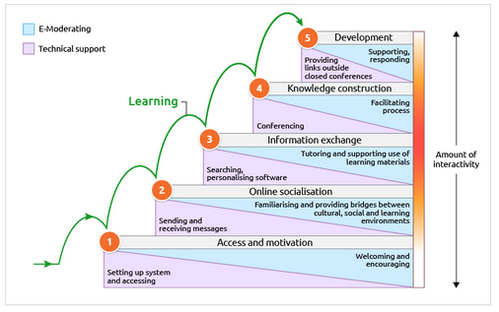The online course titled How to Design an Online Course was offered at Tampere University in the autumn of 2020. The course provided teachers with new tools and insights for planning online courses from a student-centred perspective.
One of the key insights was that an effective online course requires careful planning. Gilly Salmon’s five-stage model provides a framework for online learning. Salmon’s student-centred model is based on scaffolding, which supports students’ learning journey through a structured and paced programme of so-called e-tivities that are completed in an online environment. The model is especially well suited for designing online courses for students who are at an early stage of their studies.
It is important to identify students’ prior knowledge and skills and offer them sufficiently challenging tasks to guide them through a structured developmental process as they build up expertise and require less and less instructional support. Salmon’s model sees learners gradually taking control of their learning.
What do I need?
Information about Gilly Salmon’s five-stage model and the scaffolding strategies are openly available on her website.
What do I need to do?
When you are designing an online course, you should consider students existing knowledge and how it will affect their need for instructional support as the course progresses. You can utilise Gilly Salmon’s five-stage model to assess whether your existing course assignments and pedagogical strategies support self-directed learning among your students and whether your course design fosters communication and collaboration. You can also start designing a linear online course based on the five-stage model.

Source: Gilly Salmon, https://www.gillysalmon.com/five-stage-model.html
What should I take into account?
- At the first stage, it is important that students have access to the learning platform and are motivated to learn. Guidance provided by the teacher is essential at this stage.
- The second stage focuses on online socialisation and creating a micro-community of learners. At this stage, the teacher needs to provide a framework for students to connect with their fellow learners, build a sense of community and understand how online socialisation and connectedness will support their learning.
- The third stage is about information exchange, the building of subject knowledge and peer learning.
- At the fourth stage, students move on to tasks that require knowledge construction, critical thinking and independent reflection. A typical “problem” with online courses is that students are assigned with these types of tasks too early during the learning process, especially if they attend the course at an early stage of their studies.
- At the fifth and final stage, students are ready to work relatively independently with their group and apply their newly acquired knowledge. You should also consider providing students with metadata about learning and introduce them to reflective learning.
Read more
Salmon, G. (2021): The Five Stage Model. Available at: https://www.gillysalmon.com/five-stage-model.html.
Salmon G. (2013): E-tivities: The Key to Active Online Learning. New York: Routledge.
Salmon, G. (2011): E-Moderating: The Key to Online Teaching and Learning. New York: Routledge.
This tip was written by Salla Mikkonen
